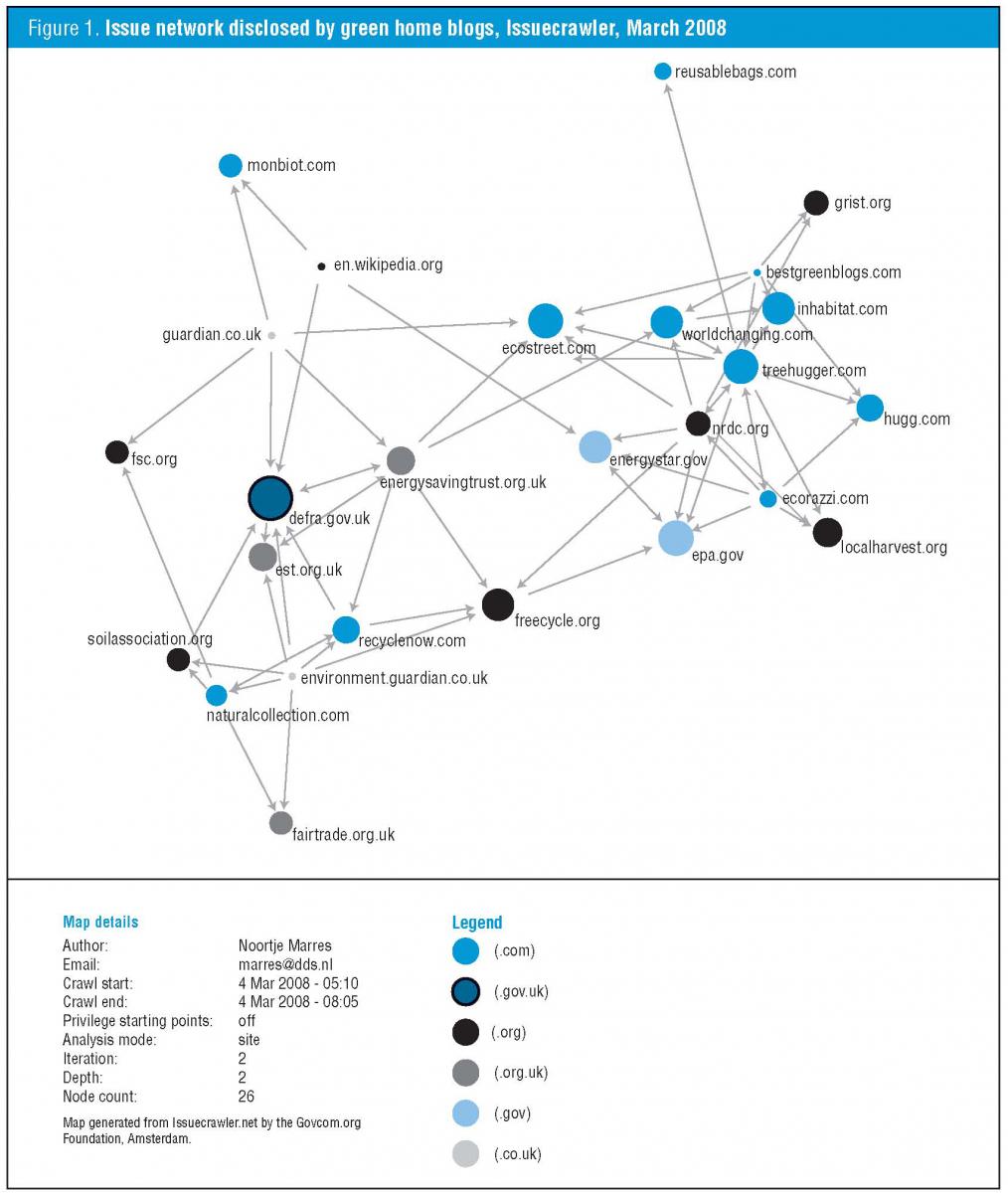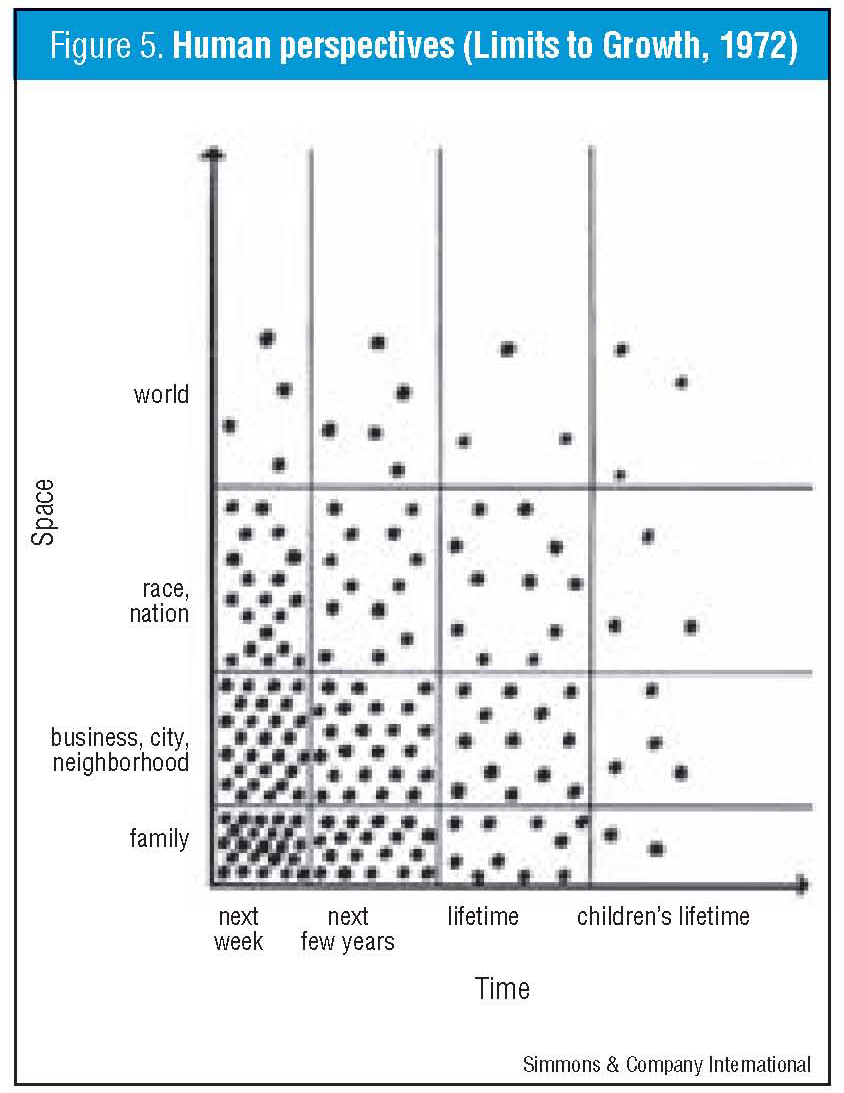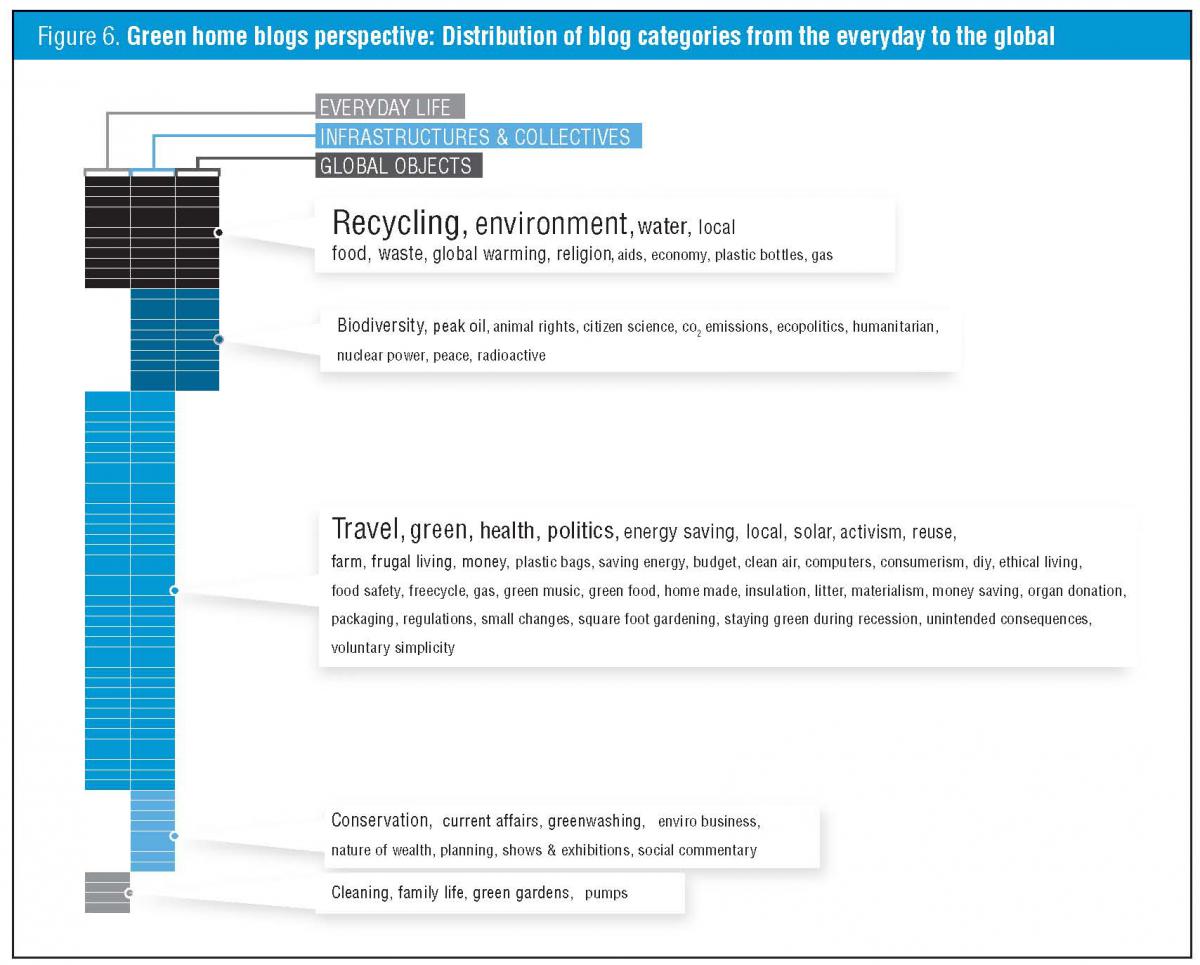What kind of space is the “sustainable home”? A comparative analysis of three “green” media spheres on the web
| Attachment | Méret |
|---|---|
| GISW2010ThematicGreenMapping_EN.pdf | 2.29 MB |
Organization
1. Introduction
In popular media as well as in the scientific literature, there exists widespread disagreement about the opportunities offered by the home as a site for environmental citizenship. The recent focus on domestic settings as a place for individuals to engage in “environmental action” is viewed critically by some, who point at the risk that public participation is here reduced to an individualistic, private, “calculative” or myopic activity. 1 From this perspective, the home presents a rather dangerous location for civic action, as engagement with complex public affairs like climate change here easily acquires an all-too-narrow focus, with attention turning to routine practices like washing and heating, and more or less obsessive attempts to reduce the amounts of energy and the other resources households use. Others, however, view the “environmental home” more favourably, as providing a space where people can explore alternative forms and practices of environmental politics. From this perspective, the home may offer a space, for instance, for developing affective and material forms of participation: engagement here can take the form not just of the voicing of opinions and arguments, as is more customary, but also of embodied practice. The sustainable home then may make possible more materially and physically sensitive forms of engagement, where getting involved with “things”, “technology” and “stuff” becomes a way of developing one’s moral and political sensibilities and experimenting with one’s habits. 2
In the analysis presented here, we turned to the web to explore this disagreement by empirical means. That is, rather than considering the differences between these two interpretations to be a conceptual matter – which depends on what theory of public participation one adheres to – we decided to translate the disagreement into a question of internet research. We asked whether and how the “environmental home” is currently being configured as a location of citizenship on the web: does it predominantly figure here as a site for private, calculative activity, or does it also feature as a space for public engagement with the environment? Furthermore, rather than treating online publicity around sustainable homes indiscriminately, as one singular media space, we decided to take a comparative approach. We delineated three different source sets, or “spheres” 3, in which “sustainable homes” figured on the web as sites of environmental engagement:
- Green home blogs: Active English-language blogs that feature the home as a place for adopting sustainable ways of life.
- Green commentary: Active English-language blogs that comment on wider issues of sustainability and the low-carbon economy (as reported in the news).
- Green issue network: A hyperlink network consisting of large US and UK governmental and non-governmental organisations.

Figure 1. Issue network disclosed by green home blogs, Issuecrawler, March 2008
In the small research exercise presented here, we then approached the web as a space for exploring how the phenomenon of the “sustainable home” is “multiply” constituted. To do so, we took up various web-based tools of social research: tools of network analysis, textual analysis and data visualisation. Such tools provide ways of examining how a given object or issue – in this case the “sustainable home” – is configured differently in different source sets or web spheres. 4 Which is also to say, using these tools of internet research, we are not obliged to treat the question of the normative possibilities that the “sustainable home” opens up for political or moral action as a question of either/or. Rather, we can explore whether and how it may be taking on multiple forms, and is ascribed multiple affordances for engagement, across the media spectrum going from the more informal and personal green home blogs to the organisational websites of governmental and non-governmental organisations. In this respect, we also wonder whether a comparative approach may provide a way of assessing the relative instability, malleability, or open-endedness of sustainable homes as a site of political and ethical engagement with the environment. 5 To what extent is its moral and political capacities currently being negotiated or contested on the web?
2. Green home typology: What kind of object is it?

Question
We begin with an exploratory question: What kind of object is “the home” according to the three green web spheres?
Method
We perform a simple textual analysis of the three source sets, querying each of them for the key word “home”, using the Google Scraper6. We select the “key word in context” data returned by the scraper for all sources in each source set, and mark up the top three returns for each source, using categories that we have interactively defined on the basis of an initial survey of the data. We count the number of mentions per category, and visualise results with the aid of the Bubbleline visualiser.
Findings and further questions
Our initial typology of the green home brings into view a number of differences and similarities among the three source sets or spheres. For instance, the more “institutional” issue network focuses on new and purpose-built homes and products, while on the more informal blogs, the home figures especially prominently as an activity space. Secondly, we note that the home does figure as a space of calculation in all three spaces, both in the narrow sense (a focus on calculating the carbon output associated with individuals, activities and settings), as well as in the broader sense (a preoccupation with resource efficiency). In this respect, the significant divergence between the source sets does not centre on how “calculative” they are in their approach of sustainable housing, but rather on the kinds of homes and objects they foreground: new builds versus existing homes, and domestic products versus domestic activities. We speculate that different types of sustainable homes may instantiate different foci of environmental action: innovation versus renovation; buying versus doing. If so, this also raises particular questions about public engagement: is it oriented towards the future (new builds) or situated in current locations (existing homes)? Is it enacted through consumption or through the informal activities associated with the domestic sphere?
3. “What you can do”: Green home blogs versus the green issue network
Question
In this second exercise, we seek to further “dis-aggregate” the sustainable home, and to consider more closely its various constituent parts. We ask: What kinds of objects and activities is the “sustainable home” made up of, in different media spaces? And: What can this tell us about the different forms of environmental engagement it may enable?
To address this question, we decided to focus on a particular “information template” that proliferates across green media sources on the web: action lists that specify “what you can do” “to help save the environment”. Such tips for personal action on the environment abound both in the green issue network and on green home blogs, but not so much on green commentary sites, so we decided to consider only the former two. Considering our question of whether the sustainable home facilitates the reduction of environmental citizenship to a merely “calculative” activity, we are interested to find out how prominently the calculative category of “resource efficiency” figures on these pages.
We then further operationalise our initial question: Do tips for “what you can do” constitute environmental action mainly as a matter of resource efficiency – of “economising” on electricity, gas and water use – or do other modes of activity and things come into play?
Method
For each source set, we manually select pages on “what you can do” from the issue network and green home blogs. From these pages, we extract key words with the aid of the textual analysis tool Open Calais. We manually categorise these terms, using categories provided by Open Calais (such as energy, materials), adding further ones on the basis of an initial survey of the data. We count mentions per category, and use the Dorling Visualizer to visualise the relative sizes of categories. Using an analyser tool, we determine unique terms per category per source set. We then manually mark up these unique terms according to four values: economy, supply, usage, service. We rearrange the Dorling visualisation to show the distribution of categories across these values.


Figures 3 and 4. “What you can do”: Green home blogs vs green issue network
Findings
This exercise, too, brings into focus some significant divergences among green home blogs and the green issue network. The categories of “energy” and “services” are big in the green issue network, while “food” and things (products, appliances, materials) are more prominent on green home blogs. In the issue network, more objects and activities are coded in terms of efficiency (saving, efficient, cost) than on green home blogs, and this framing is especially predominant in relation to energy. 7 Green home blogs place much emphasis on home-made entities, from food to cleaning materials. Comparing this to the relative prominence of services in the issue network, one could interpret this as a difference in emphasis on domesticity versus infrastructure, and perhaps, in terms of private versus public. However, these different “ontologies” disclosed by the template of “what you can do” can also be taken to articulate divergent kinds of political economies: a service economy centred on energy, or a “craft” economy concentrating on food and “other stuff”. While this is a question rather than a finding, it suggests to us that an analytical focus on the reductive power of the sustainable home (does it turn citizenship into a calculative activity?), might have its drawbacks. It might lead us to miss out on the more “expansive” work of articulation performed with the aid of green homes, namely the formulation of different possible “green” political economies.
4. Sustainable perspectives: How expansive are the space-times of green living?
Question
In this last exercise, we further explore the issue of the relative “smallness” of the sustainable home as a space for action on the environment. That is, we are interested in the “scope” of sustainable homes 8, the question of how expansive the range of issues they open up is. We would like to find out whether “sustainable living” is primarily oriented towards the immediate context of everyday living, or whether it also involves reference to, consideration of, or even intervention in, wider technological, social and political spaces that lie well beyond it.
In taking up this question of the “spatio-temporal” coordinates of the green home, we find inspiration in a diagram that featured in the Limits to Growth (1972) report9, the famous global environmental assessment that brought the environmental crisis into public view around the world, now more than three decades ago.

Figure 5. Human perspectives (Limits to Growth, 1972)
This classic figure plots human concerns across time and space, moving from more immediate to distant times and spaces. It locates the majority of people's concerns in the here and now, and as such it passes a rather bleak verdict on the public's capacity for sustainability (i.e. its ability to take into consideration the consequences of present activities that are distant in time and space).
In analogy with this figure, we ask: What is the spatio-temporal distribution of the concerns expressed in our three green web spheres? Are the more informal and “homey” green home blogs mainly preoccupied with the here and now? Do the green organisations assembled in the green issue network represent more global concerns? Does it even make sense to apply this spatio-temporal grid to these “digital formations”? 10


Figures 6 and 7. Green home blog perspectives, and the spatial distribution of the three source sets' categories compared
Method
For this exercise, we focus on the tags and categories that our sources use to organise the information they make available (postings, reports, and so on). We aggregate the tags and categories for each source set, and visualise them using the Tag Cloud Generator. We then proceed to manually attribute spatio-temporal coordinates to these categories:
x: the everyday (1), infrastructures and collectives (2), elsewhere (3)
y: the present (a), the next decade or so (b), further into the future (c)
We then seek to visualise the tag clouds spatially, which turns out to be more complicated than anticipated. This is because many categories have more than one set of spatio-temporal coordinates attributed to them.
Findings
We draw two main conclusions from this exercise:
1. The spatio-temporal framework of the “human perspectives” figure in the Limits to Growth report does not really apply to the three source sets.
One of the main “findings”, or realisations of this exercise, is that it is next to impossible to locate the “concerns” of green blogs, commentary sites and the issue network in the linear “space-time” assumed by the Limits to Growth report.
This is for two reasons. Firstly, it proved difficult to attribute straightforward temporal coordinates to the substantive categories, or “issues” treated in green media spaces: is peak oil, geo-engineering or renewable energy something of the future, present or past? To us, this is either uncertain or “all of the above”. 11 A similar problem arose in relation to spatial coordinates: is an issue like waste, water or pharmaceuticals a concern of everyday life or a global issue? Again I would say all of the above. For this reason, we decided to drop the temporal coordinates, and to accept that spatial coordinates may be “non-exclusive”. That is, in our classification, concerns or issues could be located on all spatial levels, or any combination thereof: everyday life, collectives and infrastructures, and global objects.
2. Assuming non-exclusivity of the spatial coordinates, the exercise did yield a spatial distribution of concerns.
Perhaps unsurprisingly, the more informal and “homey” green home blogs tend towards the everyday. However, possibly more surprisingly, it is not the more institutionally oriented green issue network that is most concerned with global issues, but rather critical commentary sites. And significantly, while the issue network is much concerned with consumption, it includes no issue terms that can be considered exclusive to everyday life.
Perhaps most interesting, however, are the questions this exercise raises about the spatio-temporal assumptions implied by the concept of sustainability. Sustainable is often defined in terms of the attempt to render relevant in the here and now harmful effects which are distant in space and/or time (poverty, carbon emissions, future generations, and so on). However, the sustainable web spheres under study here unsettle the neat space-time geometry that such an understanding of sustainability seems to presuppose. Objects and practice cannot be located so straightforwardly in space and time: a preoccupation with proximate objects (home-made food, for example) does not necessarily exclude attention to distant ones (carbon emissions).
So our next question would be: Do sustainability spaces on the web disclose alternative “topologies” of the environment, which problematise the equation of the everyday with the small-scale and the proximate? Could sustainable homes be locations where the space-times of public engagement with the environmental are re-imagined, or even, materially reconfigured? This may or may not be the case.
But one thing cannot go unnoticed in this respect: while the concerns expressed on green home blogs may seem expansive in some respects, in other ways the “spaces of relevance” that they open up seem to be rather restricted. As mentioned, we located the green issue network in Figure 1 by following the aggregated hyperlinks of green home blogs. And this issue network presents not an inclusive global network, but rather a centralised, government-centred political geography, with US and UK government and consumer organisations taking centre stage. While it must remain an open question what exactly can be deduced from such a pattern, we are reminded that sustainable living, in these cases at least, seems to be configured as a specifically Northern undertaking.
Notes
1 Slocum, R. (2004) Consumer citizens and the Cities for Climate Protection campaign, Environment and Planning A, 36, p. 763-782.
2 Hawkins, G. (2006) The Ethics of Waste: How We Relate to Rubbish, Rowman & Littlefield Publishers, Lanham.
3 Schneider, S. and Foot, K. (2005) Web Sphere Analysis: An Approach to Studying Online Action, in Hine, C. (ed.) Virtual Methods: Issues in Social Research on the Internet, Berg Publishers, Oxford, p. 157-170.
4 Rogers, R. (2010) Internet Research: The Question of Method – A Keynote Address from the YouTube and the 2008 Election Cycle in the United States Conference, Journal of Information Technology & Politics, 7, p. 241–260.
5 See Mol, A. (2002) The Body Multiple, Duke University Press, Durham.
6 The Google Scraper queries Google for a given source set and makes the results available for further analysis. This tool, like most of the tools used in this study, has been developed by the Amsterdam Digital Methods Initiative. They can be found online at wiki.digitalmethods.net/Dmi/ToolDatabase
7 These findings contrast with those of our initial green home typology, as there we found that green home blogs did deploy the calculative repertoire. In this respect, the findings presented here may also tell us something more specifically about the codification of “activities” on green home blogs, as here we are considering the genre of “what you can do”.
8 Michael, M. and Gaver, B. (forthcoming) Home Beyond Home: Dwelling with Threshold Devices, in Domenech, M. and Schillmeier, M. (eds.) Space and Culture, special issue on Care and the Art of Dwelling: Bodies, Technologies and Home.
9 Meadows, D. H., Meadows, D. L., Randers, J. and Behrens, W. W. (1972) Limits to Growth: A report for the Club of Rome’s Project on the Predicament of Human Kind, Universe Books, New York.
10 Latham, R. and Sassen, S. (eds.) (2005) Digital Formations: IT and new architectures in the global realm, Princeton University Press, Princeton.
11 See on this point Nowotny, H. (2002) Vergangene Zukunft: Ein Blick zurück auf die ›Grenzen des Wachstums‹, in Impulse geben – Wissen stiften. 40 Jahre VolkswagenStiftung, VolkswagenStiftung, Göttingen, p. 655-694.